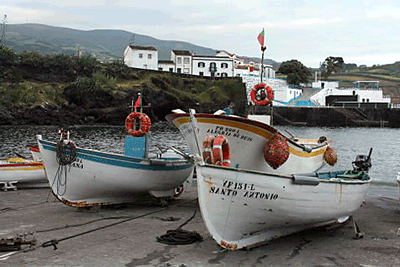
The harbor of Caloura on São Miguel. The Convent of Our Lady of Conception , in the distance, is known for its wine.
Photo ©2010 by Salvatore Laterra
Text ©2010
Long ago, when Adam and Eve left the Garden of Eden, a compassionate angel, seeing the abandoned flowers weeping there, swooped down and gathered an armful of them to carry back to a happier home in Heaven. But as the angel flew across the Atlantic, nine of the flowers fell from her arms. “And the sea clasped them, and held them…and brought all things beautiful to lay beside them. And when the angel saw this, she smiled…and blessed her beloved flowers,” and they became the Azores.
 So goes a pretty 19th-century story of the Azores’ creation, written by Boston poet Susan Dabney, who grew up there. Most of today’s Azores are much the same as those of Susan Dabney’s time, except on the largest island of São Miguel. There, development that includes modern highways and an up-to-date cruise port is well under way. But still the traveler who visits this mid-Atlantic archipelago in spring or summer will find that it is almost possible to believe Susan Dabney’s poetic tale.
So goes a pretty 19th-century story of the Azores’ creation, written by Boston poet Susan Dabney, who grew up there. Most of today’s Azores are much the same as those of Susan Dabney’s time, except on the largest island of São Miguel. There, development that includes modern highways and an up-to-date cruise port is well under way. But still the traveler who visits this mid-Atlantic archipelago in spring or summer will find that it is almost possible to believe Susan Dabney’s poetic tale.
In March and April, azaleas are in bloom everywhere; then camellias flower and when July and August come, hydrangeas — pink and blue and white — edge the fields and roads of the islands.
Lying between North America and Europe, these nine dots of islands belonging to Portugal — Santa Maria, São Miguel, Terceira, Faial, Pico, São Jorge, Graciosa, Flores and Corvo — are the westernmost point in Europe. They are not rich in glamorous casinos and elegant hotels and spas. They are quiet, gentle places where cows contentedly graze; laundry flaps in sea breezes; the men chat in village squares. Swimming, because of the terrain, is most often in rock pools, not done from sand beaches, for everywhere except on the island of Santa Maria, the sands are black and volcanic rather than white. Though winter temperatures rarely sink below 39 degrees F., in summer they almost never rise above 84 and mist and fog are frequent. With three golf courses, the Islands do, however, increasingly, attract golfers, and for generations the island of Faial has been a rest and recreation stop for yachtsmen crossing the Atlantic from west to east.
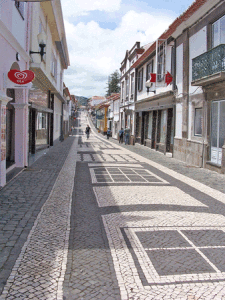
I have just returned from exploring the islands. I have enjoyed their sweeping seascapes and landscapes, the villages of whitewashed houses, the mosaic patterns on their city streets, the windmills of the archipelago (some squat, some tall), the black basalt and whitewashed stone churches on these devoutly Catholic islands. And I have drunk their wines and potent liqueurs distilled from blackberries and passion fruit, figs and pineapple. I have enjoyed the freshest of fish and shellfish just brought in from the sea.
Most visitors to the Azores arriving from Europe land on São Miguel. Forty miles long and nine miles wide, it is the largest of the islands. Travelers from the United States are more likely to land on Terceira, however, where the U.S. Air Force had a refueling station that now also serves as the commercial airport. SATA, the regional airline of the Azores, connects the islands, and in summer ferries provide another link.
It was in Terceira’s capital, Angra do Herismo, that I spent my first night in the islands. It was named a UNESCO World Heritage Site following restoration of its 17th- and 18th-century center after an earthquake in 1980. Today, elegant white houses with elaborate wrought iron balconies and doors, and window casements of slate gray or green or dust pink, line its cobblestone streets. Architecturally, Angra is considered the most beautiful of the islands’ cities. In its 17th-century heyday, trading ships filled with gold and silver from the New World frequently put into its harbor. It’s worth taking extra time to see its 19th-century Town Hall with one of the largest interior great halls in all of Portugal. The 18th-century Bettencourt Palace, that is now the public library, merits a stop to see the tile scenes of old Angra that embellish its walls. A good overview of the city and the waters beyond may be had by a garden climb to the heights of Monte Brasil.
As its name suggests, Terceira, discovered in 1450 by a Flemish explorer, was the third Azorean island to be settled. Traveling outside the capital to the beachfront town of Praia da Vitoria, one sees green and golden fields sloping down to the blue-green sea. Terceira is the island renowned for its bullfights. In the Azores, bulls held by ropes are run though the streets and contend with citizen “matadors” waving coats and umbrellas at them. On Terceira there are also some 230 “proper” bullfights. These are held between May and September and, for them, mounted, costumed matadors meet the bulls in the city bull ring. But, as is the tradition everywhere in Portugal, the bulls are never killed.
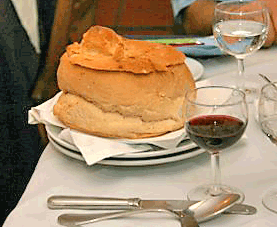
Soup in a bread bowl, photo ©2010 by Salvatore Laterra
For dinner that first night I sampled the local specialty — Alcatra. To make it, bacon fat, stew beef, onions, garlic, cinnamon, butter, vinegar and white wine are combined in an unglazed earthenware pot that must be “seasoned” before it is first used. The “seasoning” is soaking the pot in water for eight days and then cooking cabbage, potatoes and fat in it. This is said to keep the pot from absorbing the fat. Massa sovada — Portuguese sweet bread — was served with it, as was the red wine, Basalto, with a bouquet of berries, from the island of Pico. A soup of shrimp and local white fish, colorfully served in a hollowed-out round loaf of bread, was another Terceiran specialty. Everywhere in the islands, meals are introduced with an appetizer of black olives and crusty white bread , quiejo fresco (a creamy fresh cheese) and massa de pimenta (a mild but flavorful pepper sauce).
On a one-day trip from Terceira to Graciosa, the “gracious” island, I visited the main town of Santa Cruz with its tree-shaded cobblestone square, its white and black houses and the three chapels on the hill above it. But the highlight of Graciosa is its 50,000-year-old volcanic crater, the Furna do Enxofre. The approach to the crater is through a tunnel of giant ferns that are home to myriad melodious birds. Then one descends 185 steps to a bubbling pool and a lava lake. Because there are sulfurous fumes in the crater, visits must be short, however.
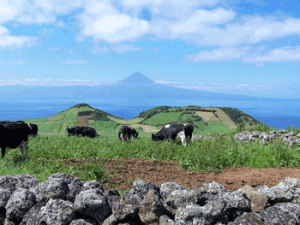
The summit of Pico as seen from a São Jorge field
Above ground on Graciosa, Frisian and Holstein cows graze on a patchwork of fields of chartreuse, dark green and gold. White-and-red windmills punctuate the landscape, but today, rather than grinding corn, they serve as guesthouses. Locally, Graciosa is known for its yellow cheese and its biscuits and cakes. The island also has two vineyards producing white wine.
Fishing is Graciosa’s principal occupation and fish dishes predominate on local tables. Malho de pescador is a fish stew frequently served, as arebodiao assado no alambique (baked parrot fish), spiny lobsters, crayfish and limpets (a barnacle-like shellfish) often baked with garlic and lemon juice. In the past, codfish, fresh or dried and salted, was a staple of the Azorean diet and could be cooked, it was said, in 365 different ways, but there has been over-fishing of cod everywhere in the Atlantic and it is no longer the staple it once was.
Faial, called the Blue Island for its abundance of hydrangeas, was my next stop. For centuries, its major harbor of Horta has sheltered the sailing vessels of the world. Sometimes these were explorers’ caravels; sometimes they were pirate ships, sometimes whalers. Today they are sleek yachts sailing across the Atlantic from the west. More than 1,000 of these a year put into Horta to pick up mail at Peter’s Café Sport on the harborfront and to stock up on supplies before continuing toward the British Isles or Europe. They leave a record of their visit by painting the name of their vessel or a symbol of it on a wall along the harbor, and it is said that failing to do so will bring bad luck.
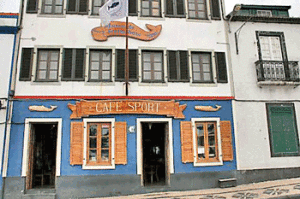
A scrimshaw museum above Café Sport harkens back to a time when whaling was an important occupation in the islands
In the scrimshaw museum above the Café Sport, one can learn much of the history of Azorean whaling. Even at the end of the 20th century, when whaling was finally banned, two-thirds of all sperm whales in the world were harpooned off the Azores. As might be expected, today, Faial is one of the top ten whale-watching sites in the world.
The scrimshaw museum’s cases are filled with chessmen and buttons, necklaces and bracelets, pipes and canes and baskets carved from whalebone as well as with polished whale’s teeth with the intricate etched decorations that make it scrimshaw. And in the ever-crowded café below, the yachtsmen of the world exchange tales of their sea crossings, as they happily down bottles of Basalto red wine, Terras de Lava red, white and rosé, and fruity white Cavaco wine, all from the nearby island of Pico. (In the 19th century, it is said, the white wines of Pico were the favorite white wines of the czars of Russia and on the Portuguese mainland).
Dining at Peter’s is eating rather than dining, with local items on the menu codfish cakes andmorcela (blood sausage with yams). Grander fare, in a grander setting, may be found nearby at the Estalagem de Santa Cruz, an 18th-century former fort turned into an elegant guesthouse and restaurant. For lunch there one afternoon, I was served Fadases cornidas do Faial en Celedao, a stew of onions and island-grown broad beans.
Touring Horta, one finds out that in the 1890s it was an important transatlantic telegraph cable station, then a meteorological station. When transatlantic flights began in the 1930s, it was used as a refueling and stopover site. In both world wars, it was an Allied naval base.

Horta on the island of Faial in the Azores
But in 1957, the volcano of Capelinhos erupted on the island, burying houses and stone walls and vineyards and half of the island’s population of 30,000 fled. Many left for the Massachsetts cities of New Bedford and Fall River. Touring the island, one can visit the lighthouse constructed at Capelinhos on land formed by a subsequent earthquake. There is also a small museum in the village of Capelo that recounts the events of the great earthquake day.
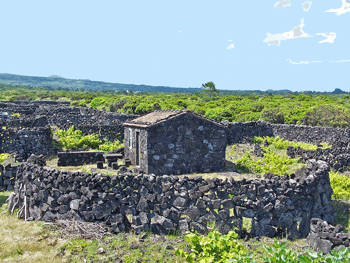
These ancient vineyard enclosures on Pico are a UNESCO World Heritage Site.
Virtually all visitors to Faial take the 20-minute boat trip to rocky little Pico, whose 7,700-foot peak is not only the highest peak in the Azores, but in all Portugal. It is a favorite climb for outdoorsmen. On Pico, following the waterfront road from the main town of Madalena, one sees black basalt rocks eroded into strange shapes by the sea and the wind. A checkerboard of two to three-foot high basaltic walls shelter wine grapes from the wind. Because they are so unusual, in 2004, these vineyards were named a UNESCO World Heritage Site. Today, grapes are also grown in a more sheltered location, however, where there is a winery that welcomes visitors.
At São Roque, on Pico, the remains of a whaling station-still active into the 1980s are open to the public, and in Lajes, at the Museo dos Baleiros, the Whalers’ Museum, are whaleboats, harpoons, scrimshaw and a film of whaling in its heyday. In those days whale-sighters on high spots shot flares into the air to alert the whalemen waiting below to put to sea, as a whale had been sighted. Today, these whale-sighters notify boats carrying whale-watching sightseers instead.)
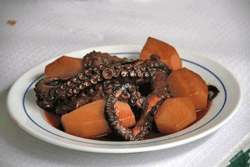
Octopus Stew photo ©2010 by Salvatore Laterra
With octopus a favorite dish of the islands, I sampled it in a stew of red and white wine, onions, garlic and tomato sauce at the Restaurant Lagoa ia Lajes. Served with it was pao de milho, a heavy corn and wheat bread. It was followed by white, soft Pico goat cheese.
São Jorge was the next island I visited, again setting out from the port at Horta, from which it is about an hour away. Sometimes São Jorge is referred to as the Switzerland of the Azores because of its precipitous cliffs and its waterfalls. Its cliffs descend almost to the ocean, but at their base are small flat lava outcroppings called fajas.
Ninety-two square-mile São Jorge is an exceptionally verdant island, even for the Azores, perhaps because it is often wreathed in fog. Because it was small, in the decades of dictatorship of Antonio de Oliveira Salazar, the island received virtually no economic support from the mainland. As a result, it was forced to produce virtually all its own food, and still is largely self-sufficient. Time was, in the 18th and 19th centuries before disease destroyed the orange trees of the Azores, that São Jorge (along with São Miguel) was an exporter of oranges to Great Britain and the United States.Today its exports are cattle and its tangy cheddar-like cheese, considered the finest cheese of the islands.
São Jorge’s principal city of Velas is a pretty little community of red-roofed white houses with wrought iron balconies. It is, however, beginning to see modern construction.
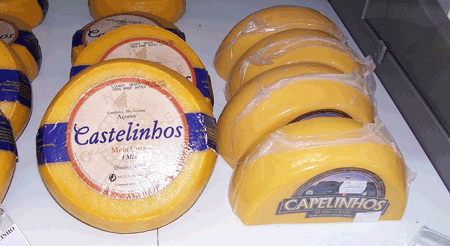
Near Calheta, São Jorge’s second largest town, is the 18th-century church dedicated to St. Barbara. There, tiles tell the story of the image of the saint being found on the shores of the island by sailors. To appropriately honor their find, they had a splendid baroque church built in her honor. Islanders also like to show off the tower of the Church of St Mateus. Only the tower of the church remained standing after an 1808 volcanic eruption.
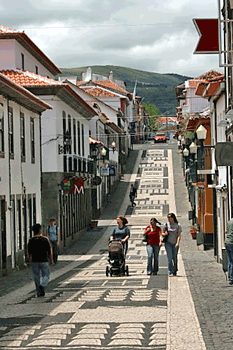
Ponta Delgada Street
photo ©2010 by Salvatore Laterra
São Miguel, 40 miles long and nine miles wide, and the most developed island of the archipelago, was the final stop on my visit. Its capital city of Ponta Delgada has, since 2008, had the only cruise terminal in the Azores. Last year it welcomed 34 vessels from many nations and is expecting 41 in the coming year. The harborfront promenade, the Avenida do Infante, even on working days, is filled with tourists and strollers and children running on the patterned sidewalk. Above the quay, too, the cobblestoned streets and narrow sidewalks may be decorated with black and white mosaic patterns of whales or sailing ships.
The island’s first capital was Vila Franca do Campo, founded in the 15th-century by settlers from southern Portugal and France. But when that city was devastated by an earthquake, the government moved to Ponta Delgada. It was already a major port for ships from Portugal, Madeira, Flanders, England and the Canaries. Vila Franca do Campo today is a waterfront village with doors gaily framed in bright blues and yellows, with the tiled images of saints set over them. Once a busy pottery center, now only one potter works at his kiln.
Today’s capital is a city of many squares edged with baroque and heavily decorated Manueline churches and convents, their ornate porthole-like windows and doors framed with black volcanic stone in a rope pattern. The 16th-century São Sebastiao Church (the Mother Church) and the convent and chapel of Nossa Senhora da Esperança are particularly important among Ponta Delgada’s religious edifices. In the latter is a much-revered statue of Christ that came to the Azores in the 16th century from Paris. Annually, on the fifth Sunday after Easter, it is paraded through the streets that are carpeted with flowers. The 18th- century former Jesuit convent church, renowned for the Portuguese baroque art it contains, is another religious site worth a visit. A military museum is housed in its 16th-century São Bras Fortress on the harborfront and on the quay below it. Early risers can watch the fishing boats come in and unload their catches.
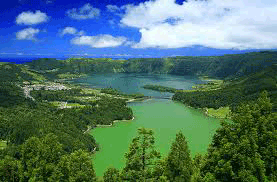
The blue and green lakes of Sete Ciudades
Outside the capital, the blue lake and the green lake of Sete Ciudades shimmer on a sunny day.There, it is said, a long ago blue-eyed princess fell in love with a green-eyed shepherd. When her father forbade the marriage, she cried so hard that a blue lake was formed, and he so hard that a green lake came into being. To reach Sete Ciudades, one drives through rich lands where cattle graze and mountains mysterious in the mist rise above the green fields.
Because of its landscape, São Miguel is known as the Green Island. But at the Valley of Furnas, muddy brown mineral waters bubble. In some of them, afiçianados of thermal baths splash. In others, Azoreans have “clambakes,” wrapping linguica (sweet pork sausage), chicken, potatoes, cabbage and fish in burlap bags and sinking them into the underground hot springs to cook for five or six hours. Then, at lunchtime, these bags of Cozido das Caldeiras are taken to a local restaurant where they are opened and their contents served. After lunch, it is pleasant to walk off the heavy fare in the Azores’ largest and finest botanical garden, the 30-acre Terra Nostra Garden. The original garden was planted in 1780 by Bostonian Thomas Hickling, the U.S. consul to the island. His particular passion was for the trees of his homeland, but only one of those, a pollarded English oak, has survived. Later owners, most recently the Bensaude family of hoteliers and ship owners, has improved and enlarged the garden. Today’s visitor walks along a serpentine canal, through grottoes and a forest of ferns. In March and April, azaleas of all colors are in bloom, followed by Malaysian rhododendrons in white and orange and pink and salmon. There is a camellia garden of more than 600 plants and a rare garden of cycads — plants that have been in existence for millions of years.
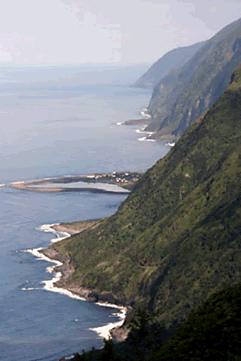
São Miguel coast, photo ©2010 by Salvatore Laterra
When its sparkling waters are not surrounded by fog, São Miguel’s Lagoa do Foga, the Fire Lagoon, is also worth a visit, and from above it, at the Pico de Fogo, on a clear day one can see all over the south and north coasts of the island. Vila de Nordeste on the windswept cliffs of the eastern side of the island, is also worth a stop.
Since the 1850s, pineapples have been grown in hothouses on the edge of Ponta Delgada and these are often on tourist itineraries. São Miguel also has two tea plantations that welcome guests.
Sadly, I missed seeing Santa Maria, Corvo and Flores on my Azorean journey. Corvo, shaped like a crow, is only three by two miles, the smallest and most remote of the islands and the principal sight to see is its volcanic crater, one of the largest in the archipelago. Fifty-five-square-mile Flores has, I was told, a rugged landscape of hydrangea-edged fields, honeysuckle, ice plants and rhododendrons, and cliffs that are bedecked in golden flowers in summer. There are also waterfalls and seven lakes, ferns in its grottoes and fresh-smelling firs and cedars along its roads. The walks one can take on Flores are said to be the most beautiful of all the islands.
At São Laurençco on Santa Maria is the Azores’ finest beach. It is of smooth white sand. It was on Santa Maria, too, that Columbus’s crew stopped to pray on their return from America in 1493, walking to the chapel naked except for their shirts, for they had promised the Virgin Mary that that was what they would do if she helped them to find land. In World War II, the island was an American military base.
IF YOU GO:
SATA International (1-800-762-9995 or 508-677-0555, www.sata.pt), the Azorean airline, flies from Boston to São Miguel or Terceira, depending on the season, and Azores Express, a subsidiary, flies between the islands. In summer, there are several ferry services linking the islands.
Further information is available from the Portuguese National Tourist Office, 590 Fifth Ave., New York, N.Y.10036-4702; 646-723-0200 or 10800 Portugal, or fromwww.visitportugal.com
& & &
